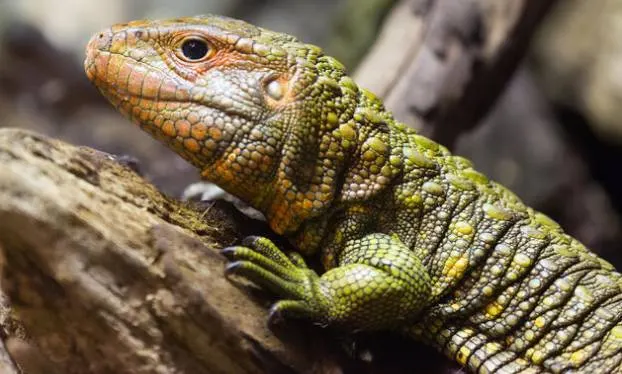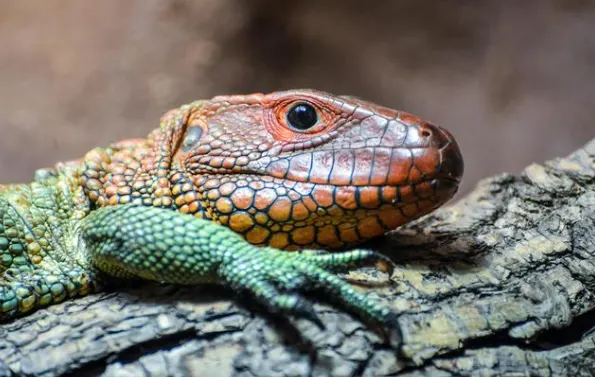The caiman lizard, a remarkable and semi-aquatic reptile native to South America, is a fascinating creature that captures the imagination of reptile enthusiasts and wildlife experts alike. With its crocodilian-like features and vibrant colors, the caiman lizard stands out as one of the most intriguing members of the lizard family. In this comprehensive guide, we’ll delve into the various aspects of the caiman lizard’s biology, behavior, habitat, diet, and conservation status.

Table of Contents
Scientific Classification
The caiman lizard belongs to the Teiidae family, which is also known as the New World Runners. Its scientific genus is Dracaena, with two recognized species: Dracaena guianensis (Northern Caiman Lizard) and Dracaena paraguayensis (Paraguay Caiman Lizard). The name Dracaena is derived from the Greek word drakaina, meaning “female dragon” or “serpent,” reflecting the lizard’s formidable appearance.
Physical Characteristics
Caiman lizards are among the largest lizard species, with adults growing to lengths of 2 to 5 feet and weighing between 8 to 12 pounds. The males of the species typically reach the larger end of this range, while females are generally smaller. The lizard’s body is covered with large, crocodile-like scales, giving it a rugged appearance. Its tail is elongated and flat, aiding in swimming and balance.
These lizards come in various colors depending on the subspecies. The Northern Caiman Lizard is known for its vibrant coloration, including green bodies, red or orange heads, and brown or black tails. In contrast, the Paraguay Caiman Lizard has more muted tones, such as gray or tan, across its body.
Behavior and Habitat
Caiman lizards are semi-aquatic and thrive in both terrestrial and aquatic environments. They are predominantly found in the warm climates of South America, including regions of Bolivia, Brazil, Colombia, Ecuador, French Guiana, Paraguay, and Peru. Their natural habitats include forests, wetlands, flooded woodlands, and savannas.
These lizards are excellent swimmers and spend a significant amount of their time in water. They use their tails to propel themselves and can swiftly escape from predators by diving into the water. Caiman lizards are diurnal, meaning they are active during the day and rest at night, often in bushes or trees.
Despite their semi-aquatic lifestyle, caiman lizards are quite adaptable. They are capable of climbing, running, and even using their tails for defense. Their diet is varied, but they are particularly skilled at hunting invertebrates with hard shells.
Diet and Feeding Habits
Caiman lizards are carnivorous and have a diet that consists primarily of snails, particularly apple snails, as well as insects, freshwater clams, fish, amphibians, and small rodents. They are equipped with powerful jaws and molar-like teeth that allow them to crush hard shells and efficiently extract the meat from their prey. This ability makes them well-suited to consuming a range of invertebrates and small animals.
Reproduction and Life Cycle
Caiman lizards are oviparous, meaning they lay eggs rather than giving birth to live young. Females lay between 5 to 10 eggs in nests dug along riverbanks. The eggs are incubated for about 179 days before hatching. Upon hatching, the young, called hatchlings, are about 5 inches long and are immediately self-sufficient. They are capable of walking and swimming within hours of hatching.
In captivity, caiman lizards can live for over a decade, with some reaching the age of 12 or more. In the wild, their lifespan is less well-documented but is believed to be around 10 years. These lizards are prone to various health issues, including infections and parasites, which can be managed with proper veterinary care.
Conservation Status
The conservation status of caiman lizards is currently listed as “Least Concern” by the International Union for Conservation of Nature (IUCN). Despite this, they face threats from habitat loss due to deforestation and pollution. Historically, caiman lizards were hunted for their skins, but they are now protected under the Convention on International Trade in Endangered Species of Wild Fauna and Flora (CITES). This protection helps regulate trade and reduce exploitation.
Frequently Asked Questions
1. Do caiman lizards make good pets?
Caiman lizards can make interesting pets for experienced reptile keepers. They require spacious enclosures with both land and water areas, temperatures between 80 and 90 degrees Fahrenheit, and humidity levels of 60 to 80 percent. Due to their size and specific care needs, they are not suitable for novice pet owners. Additionally, the cost of purchasing and maintaining a caiman lizard can be significant.
2. How big do caiman lizards get?
Adult caiman lizards typically grow to lengths of 2 to 5 feet and weigh between 8 to 12 pounds. Males tend to be larger than females, with some reaching up to 5 feet in length.
3. Are caiman lizards dangerous?
Caiman lizards are generally not considered dangerous. They are known for their even-tempered nature and are not typically aggressive unless provoked. However, their bite can be painful if they feel threatened.

4. How much does a caiman lizard cost?
The cost of a caiman lizard can vary widely, ranging from $350 to $1,500. The final price depends on factors such as the lizard’s age, size, and subspecies, as well as the costs associated with proper care and housing.
5. Do caiman lizards bite?
While caiman lizards will bite if they feel threatened, they are not generally aggressive. Their bites can be severe and should be avoided by handling them carefully and respecting their space.
The caiman lizard is a remarkable example of the diversity and adaptability of reptilian life. Its combination of crocodilian features and vibrant coloration makes it a standout species in the reptile world. By understanding their behavior, diet, and conservation needs, we can better appreciate and protect these fascinating creatures. Whether in the wild or in captivity, the caiman lizard continues to captivate the interest of those who study and admire it.
- Enchi Ball Python: A Unique and Stunning Morph of Python regius - March 27, 2025
- Emerald Tree Monitor: The Enigmatic Green Guardian of the Rainforest - March 26, 2025
- The Egyptian Cobra (Naja haje): A Fascinating Serpent - March 25, 2025
